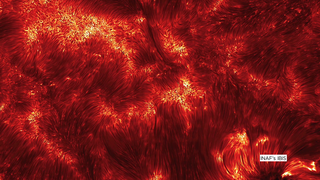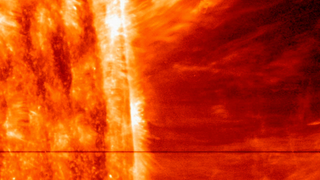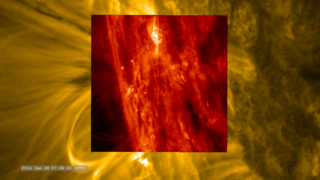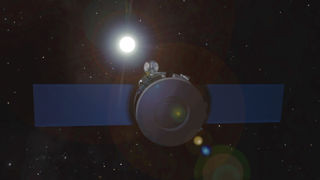A First for NASA's IRIS: Observing a Gigantic Eruption of Solar Material
IRIS must commit to pointing at certain areas of the sun at least a day in advance, so catching a CME in the act involves some educated guesses and a little bit of luck.
"We focus in on active regions to try to see a flare or a CME," said Bart De Pontieu, the IRIS science lead at Lockheed Martin Solar & Astrophysics Laboratory in Palo Alto, California. "And then we wait and hope that we'll catch something. This is the first clear CME for IRIS so the team is very excited."
The IRIS imagery focuses in on material of 30,000 Kelvin at the base, or foot points, of the CME. The line moving across the middle of the movie is the entrance slit for IRIS's spectrograph, an instrument that can split light into its many wavelengths – a technique that ultimately allows scientists to measure temperature, velocity and density of the solar material behind the slit.
The field of view for this imagery is about five Earth's wide and about seven and a half Earth's tall.
The IRIS Observatory was designed by and the mission is managed by Lockheed Martin Solar & Astrophysics Laboratory. NASA's Ames Research Center in Mountain View, California, provides mission operations and ground data systems. NASA's Goddard Space Flight Center in Greenbelt, Maryland, manages the Explorers Program for NASA's Science Mission Directorate in Washington, D.C.
Used Elsewhere In
Related
Credits
Genna Duberstein (USRA): Producer
Bart De Pontieu (Lockheed Martin Solar and Astrophysics Lab): Scientist
Karen Fox (ADNET Systems, Inc.): Writer
NASA's Goddard Space Flight Center
https://svs.gsfc.nasa.gov/11556
Missions:
IRIS: Interface Region Imaging Spectrograph
SDO
SOHO
STEREO
This item is part of this series:
Narrated Movies
Goddard TV Tape:
G2014-048 -- IRIS' First CME
Keywords:
SVS >> HDTV
SVS >> Solar Wind
GCMD >> Earth Science >> Sun-earth Interactions >> Solar Activity >> Solar Ultraviolet
SVS >> Space Weather
SVS >> Heliophysics
NASA Science >> Sun
SVS >> IRIS Mission
GCMD >> Earth Science >> Sun-earth Interactions >> Solar Activity >> Coronal Mass Ejections
GCMD keywords can be found on the Internet with the following citation: Olsen, L.M., G. Major, K. Shein, J. Scialdone, S. Ritz, T. Stevens, M. Morahan, A. Aleman, R. Vogel, S. Leicester, H. Weir, M. Meaux, S. Grebas, C.Solomon, M. Holland, T. Northcutt, R. A. Restrepo, R. Bilodeau, 2013. NASA/Global Change Master Directory (GCMD) Earth Science Keywords. Version 8.0.0.0.0















